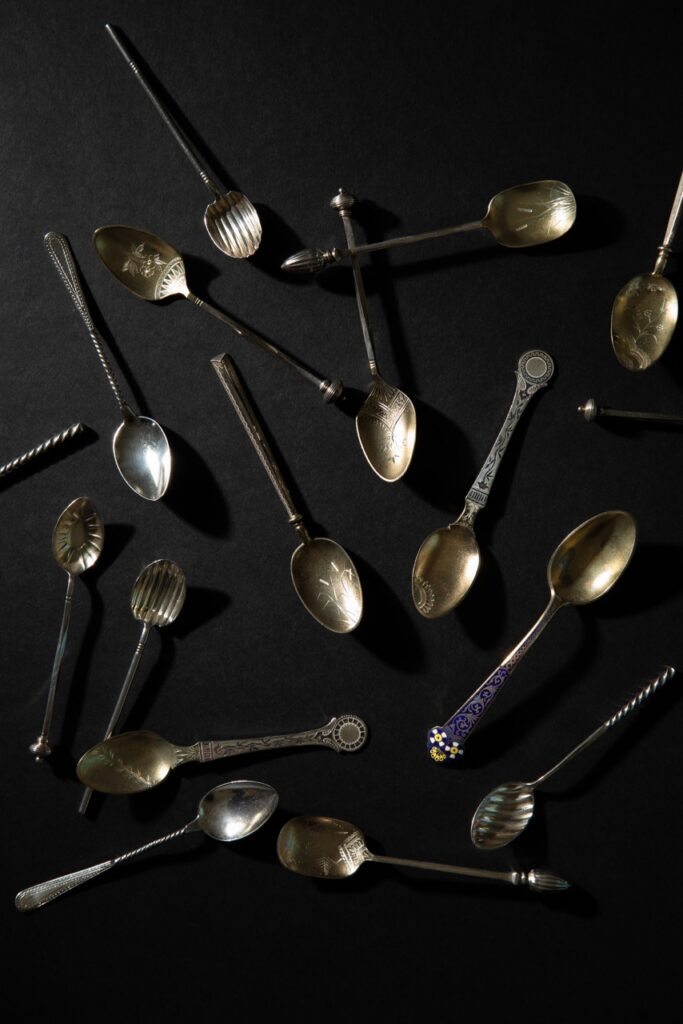Clayton, the Frick family’s Pittsburgh home, sheltered Henry and Adelaide Frick and their three children. It also housed the numerous staff members who kept the Fricks looking polished and well organized. Hands from both groups played roles in acquiring, using, and maintaining the objects that populate this splendid museum today. The Frick Pittsburgh’s Chief Curator and Director of Collections, Dawn R. Brean, and Morgan Lawrence, Manager of Collections and Exhibitions, shared some of Clayton’s gilded tableware treasures with TABLE readers.
The Frick Family’s Gilded Tableware

Bonbon Spoons
“You never would touch any food with your hands, only with a utensil,” comments Dawn R. Brean. These elaborate spoons would have served chocolates and sweet treats during an elaborate lunch, teatime or dinner. The spoons were probably given to the Fricks as wedding gifts in 1881. No longer part of our daily lives, the bonbon spoon is one of many types of tableware that were an opportunity for the wealthy of the Gilded Age to show off their status and their understanding of the multifaceted table manners of the day. If you could navigate your way through the accoutrements of the upper classes, you belonged. As today’s teens might say: IYKYK.

Venetian Goblets
Like many across the centuries, the Fricks purchased souvenirs and keepsakes when they traveled. During an 1893 visit to Venice, they selected a suite of engraved and gilded coupes, goblets, cordial glasses, finger bowls and plates, decanters, and ice cream shells (dishes) from a luxury boutique run by the Testolini family on St. Mark’s Square. (It’s now Pauly & C., and you can still visit their gorgeous store in the heart of Venice.) Adelaide Howard Childs Frick’s monogram, AHCF, is etched into each piece. This is because choosing these items, and deciding when to use them, was squarely in her aegis. Brean says that the amount of wear and tear visible on the gilding indicates that these sumptuous pieces had frequent use.

Coffee Spoons
Brean reports that The Frick Pittsburgh has at least 30 coffee spoons in the collection. Some are gilded. Others sport enamel details. Some are twisted, hammered, or stamped. Still others are finely etched with flowers, insects, fans, and other details, often in the Japanese-influenced aesthetic popular in the American Arts and Craft movement. Some may have been given as wedding gifts, but their profusion suggests that they may have been gifted to the Fricks across many years. The spoons would have been used during coffee service after dinner, at card parties, and perhaps during the quick social calls that were common between women in the late 19th and early 20th centuries.

Cabinet Plates
These beauties almost never left the dining room’s china cabinets, where they would have provided a sumptuous backdrop for Mrs. Frick’s crystal and glassware. The array of patterns shows a late 19th century taste for eclecticism. These represent Art Nouveau, Rococo Revival, Directoire, Classical, and Aesthetic styles, among others. “What I love about the 19th century is the mixing and matching. They were shameless materialists back then, and more was definitely more,” comments Brean with humor, noting that the museum has at least 15 sets of dinnerware that belonged to Mrs. Frick. What was on the table during meals? “White china with simple gilded decorations was used everyday. On special occasions, however, patterns like the one on the lower left of the photo were likely to be on the table,” explains Brean.

Silver Place Settings
Most likely a wedding gift or wedding purchase, the sterling silver salad and dinner forks, and soup and dessert spoons, shown here are by Tiffany & Co. Popular in the 1880s, each of the 15 shapes within the Audubon pattern had its own bird and flower combination, bringing joyous depictions of the natural world to every meal. Mixed in with the Audubon pattern, the pearl-handled knives were also part of the Fricks’ everyday tableware.

Serving Pieces
The berry spoon (top), fish knife (center), and pie server (bottom) represent some of the many, many shapes required at Gilded Age tables, but which have fallen out of common use in our time. Who could spot a fish knife these days? Just over a century ago, however, subtle differences in their shapes would have explained the function of each piece to those in the know. Mrs. Frick, raised in a well-to-do family, would have known her way around these objects. So would the English butlers who helped her run Clayton over the decades, like Frank Richards and Joseph Holroyd. Mr. Frick, not born and raised with this sort of status-affirming kit, might have needed a little coaching from time to time.
To learn more about the Frick family and the people “downstairs” who made life at Clayton possible, get a ticket to the Gilded, Not Golden tour of the house. It looks beyond the opulence and into the upheaval and inequity of the era.
Special thanks to The Frick Pittsburgh, Dawn R. Brean, Kristin Garbarino, and Morgan Lawrence.
Story by Keith Recker
Photography by Dave Bryce
Subscribe to TABLE Magazine’s print edition.
